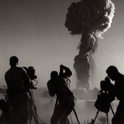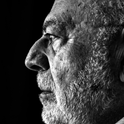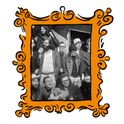The Californian rock formation known as the Pinnacles plays a central role in Kunzru’s novel—but just what it symbolises remains elusive. Image: Steve Berardi
Gods Without Menby Hari Kunzru (Hamish Hamilton, £12.99)
At first glance, Hari Kunzru’s fourth novel, Gods Without Men, seems like a departure from his previous three, all of which give the reader a main character to follow—through picaresque adventures in The Impressionist; a collision between the “real” and the cyber world in Transmission and most recently, in My Revolutions, the resurfacing of a hidden past. For a long stretch of Gods Without Men, however, the only obvious unity is that of place, a formation of rocks in the central California desert called the Pinnacles.
In the opening scenes we meet an English rock star who has run out on the recording of his next album in a combination of drug-induced paranoia and homesickness. He holes up in the Drop Inn motel near the Pinnacles with a bag of peyote and a gun stolen from his producer. Characters in other timelines include an aircraft engineer in 1947 who sets up in a bunker in the rocks to broadcast in Morse code to extraterrestrials, and an ethnologist in the 1920s who knows “more about the mythology of salmon than any white man alive.” Another strand is the near present-day story of Jaz Matharu, a mathematician who works for a hedge fund, his wife Lisa, and their autistic four-year-old son.
The different strands, time zones and forms (including the reports of an 18th-century Spanish friar) recall the structure of David Mitchell’s Cloud Atlas. But Gods Without Men isn’t an ingenious jigsaw puzzle which fits neatly together. Nor does Kunzru display Mitchell’s hectic ability to make up voices (although he did in his earlier novels); his gift here is for the muted, sideways summaries that one character makes of another. For example, Jaz finds Cy Bachmann, his boss, hard to read: “There was something about the man which brought on a sort of hermeneutic despair. He was a forest of signs.” Similarly, when we learn about Jaz’s preparations to apply to MIT, his family’s devotion to the cause is conveyed like this: “His mother and sisters moved around like ground technicians on an immigrant moon-shot.”
Once we learn that the Matharus are staying at the Drop Inn, more characters from what seemed like isolated episodes in different timelines reappear in “other” stories. But if everything and everyone is connected, what do the coincidences mean?
Just as this question becomes particularly pressing, someone comes along with what seems like an answer. In 2008, on pre-crash Wall Street, Jaz’s job is to find patterns in data and feed them into a new mathematical model which can tell his hedge fund what kind of trades to make. In addition to finding statistical relationships between, for instance, commodity prices and government bond yields, he’s asked to analyse the arms sales in the Horn of Africa, industrial injuries and drug busts. To Jaz’s surprise he does find patterns in this jumble. When he wonders if this is any basis for making actual transactions—“Surely this is meaningless coincidence,” he says—his boss replies: “We’re juxtaposing things, listening for echoes. It’s not some silly cybernetic dream of command and control… It’s certainly not a theory of everything. I don’t have a theory of any kind. What I have is far more profound… A sense of humour.” This heavy-handed answer reads like a thinly veiled explanation from Kunzru and comes only a third of the way through the novel, so why carry on?
The incentive to continue reading lies in the way the novel provides many plots but doesn’t bring any of them to a conclusion; there’s no dénouement where we find out who did it or even what, exactly, was done. A number of the strands trail away with the characters looking at the Pinnacles. In the end, all we can say is that the rocks are “symbolic”—but it’s much harder to say what they stand for. This may sound frustrating but in practice it’s far from boring (though a world away from the proof copy’s blurb of “compulsively readable”).
Is it the landscape that affects all the characters, or do the characters happen to be the kind of people who are drawn to this kind of landscape? Only the author can tell us, since, unlike his creation Cy Bachmann the hedge-fund entrepreneur, Kunzru really is in charge of a kind of command-and-control centre. Then again, he may already have explained what he’s up to. In a 2007 interview Kunzru said, “The thing that is entirely consistent through[my] books is this question of what remains the same for a person through all possible circumstances, and what changes. How much of your self and your sense of yourself are dependent on context… I’ve got a nasty feeling that I’m going to repeat that again and again.”
Kunzru’s refusal to offer explanations within the novel, combined with the carefully patterned structure, doesn’t always work (he’s guilty of the odd mystical moment). But it’s refreshingly uncompromising.
Gods Without Menby Hari Kunzru (Hamish Hamilton, £12.99)
At first glance, Hari Kunzru’s fourth novel, Gods Without Men, seems like a departure from his previous three, all of which give the reader a main character to follow—through picaresque adventures in The Impressionist; a collision between the “real” and the cyber world in Transmission and most recently, in My Revolutions, the resurfacing of a hidden past. For a long stretch of Gods Without Men, however, the only obvious unity is that of place, a formation of rocks in the central California desert called the Pinnacles.
In the opening scenes we meet an English rock star who has run out on the recording of his next album in a combination of drug-induced paranoia and homesickness. He holes up in the Drop Inn motel near the Pinnacles with a bag of peyote and a gun stolen from his producer. Characters in other timelines include an aircraft engineer in 1947 who sets up in a bunker in the rocks to broadcast in Morse code to extraterrestrials, and an ethnologist in the 1920s who knows “more about the mythology of salmon than any white man alive.” Another strand is the near present-day story of Jaz Matharu, a mathematician who works for a hedge fund, his wife Lisa, and their autistic four-year-old son.
The different strands, time zones and forms (including the reports of an 18th-century Spanish friar) recall the structure of David Mitchell’s Cloud Atlas. But Gods Without Men isn’t an ingenious jigsaw puzzle which fits neatly together. Nor does Kunzru display Mitchell’s hectic ability to make up voices (although he did in his earlier novels); his gift here is for the muted, sideways summaries that one character makes of another. For example, Jaz finds Cy Bachmann, his boss, hard to read: “There was something about the man which brought on a sort of hermeneutic despair. He was a forest of signs.” Similarly, when we learn about Jaz’s preparations to apply to MIT, his family’s devotion to the cause is conveyed like this: “His mother and sisters moved around like ground technicians on an immigrant moon-shot.”
Once we learn that the Matharus are staying at the Drop Inn, more characters from what seemed like isolated episodes in different timelines reappear in “other” stories. But if everything and everyone is connected, what do the coincidences mean?
Just as this question becomes particularly pressing, someone comes along with what seems like an answer. In 2008, on pre-crash Wall Street, Jaz’s job is to find patterns in data and feed them into a new mathematical model which can tell his hedge fund what kind of trades to make. In addition to finding statistical relationships between, for instance, commodity prices and government bond yields, he’s asked to analyse the arms sales in the Horn of Africa, industrial injuries and drug busts. To Jaz’s surprise he does find patterns in this jumble. When he wonders if this is any basis for making actual transactions—“Surely this is meaningless coincidence,” he says—his boss replies: “We’re juxtaposing things, listening for echoes. It’s not some silly cybernetic dream of command and control… It’s certainly not a theory of everything. I don’t have a theory of any kind. What I have is far more profound… A sense of humour.” This heavy-handed answer reads like a thinly veiled explanation from Kunzru and comes only a third of the way through the novel, so why carry on?
The incentive to continue reading lies in the way the novel provides many plots but doesn’t bring any of them to a conclusion; there’s no dénouement where we find out who did it or even what, exactly, was done. A number of the strands trail away with the characters looking at the Pinnacles. In the end, all we can say is that the rocks are “symbolic”—but it’s much harder to say what they stand for. This may sound frustrating but in practice it’s far from boring (though a world away from the proof copy’s blurb of “compulsively readable”).
Is it the landscape that affects all the characters, or do the characters happen to be the kind of people who are drawn to this kind of landscape? Only the author can tell us, since, unlike his creation Cy Bachmann the hedge-fund entrepreneur, Kunzru really is in charge of a kind of command-and-control centre. Then again, he may already have explained what he’s up to. In a 2007 interview Kunzru said, “The thing that is entirely consistent through[my] books is this question of what remains the same for a person through all possible circumstances, and what changes. How much of your self and your sense of yourself are dependent on context… I’ve got a nasty feeling that I’m going to repeat that again and again.”
Kunzru’s refusal to offer explanations within the novel, combined with the carefully patterned structure, doesn’t always work (he’s guilty of the odd mystical moment). But it’s refreshingly uncompromising.












